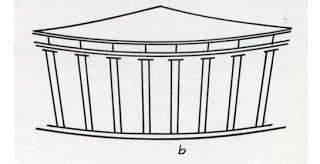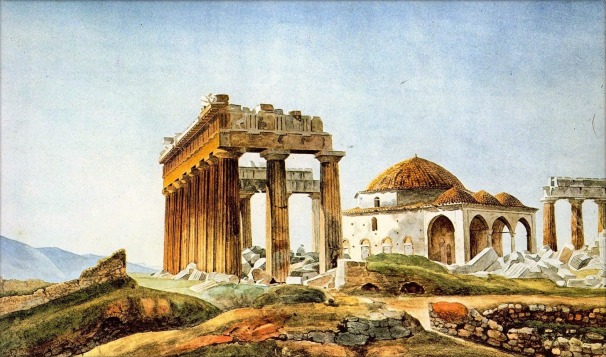I WAS UP AT the British Museum last week and was, as usual, suitably fascinated by the Parthenon marbles. The Parthenon, on the Acropolis in Athens, has been under repair now since the Committee for the Conservation of the Acropolis Monuments was set up in 1975 and serious restoration work began on the Parthenon around 1985. That was 30 years ago and still there is much to do. Back in the 5th century BC it took the ancient Greeks 9 years to build it (447-438 BC) – there’s advancement for you! To be fair, since 1985 there has been a lot of dismantling of previously flawed repairs carried out by the likes of messrs Kyriakos Pittakis (from 1842 to 1844) and Nicholaos Balanos (from 1895 to 1933). These guys, although well-meaning, used a lot of concrete and iron which has not proven to be a lasting success! It is not planned to restore the Parthenon to its original state, but just to a more appropriately safe ruin and restoring loose blocks to where they belong.
The Parthenon today (NW sides)
The construction of it (in pentelic marble from nearby Mount Pentelicus) back in the 5th century BC was clever stuff – its columns look uniform and straight but they are not. The building is, in fact, an optical illusion. If it had been built uniform, with all the columns straight and exactly the same size it would have been seen to the eye as shrunken in the middle. The columns on the ends are slightly larger than the others and bend inwards.
Outside columns bend in
Drawing a is how it should look to the eye
Drawing b is how it would look to the eye if all the columns were uniform
Drawing c is how it is actually built to look like (to the eye) drawing a
It’s had a somewhat ‘interesting’ history. Other than a fire in the 3rd century AD, which destroyed its roof and part of the inner sanctuary, it lasted quite well, complete with its massive golden statue of Athena. Then, in the 5th century AD, as part of the new Byzantine Empire, the statute was looted and taken to Constantinople, where it was later destroyed, probably around 1209 during the fourth Crusade.
Replica of the statute of Athena in Nashville, USA – big, huh!
Towards the end of the 6th century AD the Parthenon was converted to a Christian church and the main entrance changed from the east to the west, with an altar set up at the east-end with the addition of an apse. A bell tower with spiral staircase was built into the southwest corner.
In 1458 the Ottoman Turks took control of Athens and some years later converted the Parthenon into a mosque. However, the basic external structure remained intact.
Parthenon as a mosque complete with minaret
Then in 1687 came the Venetians and one Francesco Morosini. He lay siege to the Acropolis and began shelling it with mortar (shells not cement ….. yeah, ok). For some inexplicable reason the Turks were using the Parthenon as an ammunition store. A mortar shell landed directly on it and the whole lot exploded, killing around 350 Turks.
Exploding Parthenon – it’s never been the same since!
It’s not clear whether Morosini aimed at the Parthenon on purpose or it was (un)lucky shot. Presumably the Turks (naively) thought he would not fire on such an important building, but if he knew it was an ammunition store ……..well, what would you do in his shoes? Anyway, having taken the Parthenon, he tried to loot some of the sculptures and caused even more damage. The following year the Venetians left Athens and the Turks reoccupied the city. They built a small mosque within the ruins of the Parthenon and remained in power in Athens until Greek independence in 1832. The mosque was removed sometime after 1834, together with many other non-classical architecture on the Acropolis (an enthusiasm of classical Greece had taken hold by then).
Painting of mosque no 2 in the ruins of the Parthenon (c. 1715)
Prior to the Greek independence, in 1801 along came Lord Elgin with his dodgy firman (permission to draw the ruins and take casts). He decided to interpret the firman to allow him to remove sculptures (including those on the Parthenon from the east and west pediments, the high relief metopes around the outside, and the low relief frieze around the inside – see pic below). The Ottomans didn’t seem too bothered (not being very interested in ancient pagan worship) and no doubt money changed hands. The arguments will continue as to whether Elgin was right to do so. There is evidence that some remaining marbles did deteriorate being left unprotected, but it is doubtful whether that was Elgin’s real reason for removing what he did.
The different sculptures on the Parthenon
Example of female (goddesses) sculptures taken by Elgin from the east pediment
Reconstruction of above sculptures – they would have been painted in colour
So, should the marbles be returned to Athens? Let’s not go there! Although I would say that my original thoughts were in the affirmative now Athens has its fabulous new museum. The problem is, where do you draw the line? Do we return everything to everyone? That wouldn’t leave much in our museums …….
Parthenon at night – pretty
.
Next week: Juries – a good thing or a bad thing?
Artemus Smith’s Notebooks
I continue my research of the notebooks of Dr Artemus Smith, archaeologist of great courage, determination and fiction. Here is another extract:
My good friend Archibald Lumbago was fairly depressed about the state of his farming business. The Department of Employment (DoE) had heard that he was not paying proper wages to his helpers and sent one of its staff out to investigate him. He recounted the conversation to me:
“When the DoE chappie arrived he asked for a list of my employees and how much I pay them. I replied, ‘Well, there’s my farm hand who has been with me for 3 years. I pay him £200 a week plus free room and board.’ I continued, ‘Then there’s the mentally challenged worker. He works about 18 hours every day and does about 90% of all the work around here. He makes about £20 per week, pays his own room and board, and gets a bottle of whisky every Saturday night so he can cope with life.’
The DoE chappie said, ‘That’s the guy I want to talk to … the mentally challenged one.’
I replied, ‘That would be me.'”














Thanks, Dudley.
I agree with you about the return of the marbles now that there is somewhere to put them – and it would free up the B.M. gallery for lots more goodies!
Best wishes,
Maria